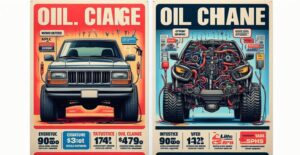Keeping track of oil changes is essential for maintaining your vehicle’s performance and longevity, and oil change stickers are a simple way to stay organized. These stickers act as reminders for upcoming maintenance, helping you avoid costly repairs down the road. However, proper installation is crucial for ensuring they remain visible and functional. In this blog, we’ll share essential tips for installing oil change stickers effectively, covering everything from choosing the right location to ensuring optimal adhesion. Let’s dive in!
Why Oil Change Stickers and Decals?
Oil change stickers and decals are essential for maintaining the health of your vehicle. They serve as reminders of when your next oil change is due, helping you avoid costly engine damage caused by neglecting this vital maintenance task. By clearly displaying the next oil change date or mileage, these stickers promote routine maintenance and enhance vehicle longevity.
Moreover, they can be a valuable tool for resale; potential buyers will appreciate the documented maintenance history. Some businesses use these stickers to boost customer loyalty, creating a sense of trust that you care about their vehicle’s upkeep. In essence, oil change stickers are small but powerful tools for vehicle management, ensuring that both vehicle owners and service providers stay on the same page regarding maintenance schedules.
What Material Are Oil Change Stickers Made Of?
Oil change stickers are typically made from durable materials designed to withstand the elements. Common materials include vinyl and polyester, which are resistant to fading, tearing, and peeling. These materials can endure exposure to oils and automotive fluids, ensuring the sticker remains legible for its intended lifespan.
Many oil change stickers also feature a protective laminate layer, providing extra durability and water resistance. This laminate helps prevent ink from smudging or washing away, keeping your information clear and visible. Additionally, some stickers come with a low-tack adhesive that allows for easy removal without damaging the vehicle’s surface. The right material not only enhances visibility but also contributes to the longevity of the sticker.
Oil Change Sticker Features

When selecting oil change stickers, it’s important to evaluate various features that enhance their functionality and effectiveness. Here are some key features to consider:
- Critical Information Sections:
- Most oil change stickers are designed with clear sections to include essential details such as the date of the last oil change and the mileage at which the next change is due.
- Some stickers also provide space for additional information, like the type of oil used or the name of the service provider.
- Pre-printed Templates:
- Many stickers come with pre-printed fields that guide service providers on what information to fill out, streamlining the process.
- This helps maintain consistency in recording data and reduces the chances of omitting critical information.
- Visibility Enhancements:
- Bright colors and bold fonts are common features in oil change stickers, making them easily visible at a glance.
- High-contrast designs help ensure that the sticker stands out, allowing for quick reference, especially in busy or cluttered environments.
- Customizable Options:
- Some brands offer customizable stickers that allow businesses to print their logos or branding alongside the service information.
- Custom stickers can help foster brand recognition and loyalty among customers while providing essential maintenance reminders.
- Weather Resistance:
- A high-quality oil change sticker is made from durable materials resistant to various weather conditions, including UV rays, rain, and oil spills.
- This durability ensures that the information remains intact and legible over time, even in harsh environments.
- Easy Application and Removal:
- Look for stickers designed for easy application, minimizing the risk of bubbles or misalignment during installation.
- Features such as low-tack adhesive or static cling options allow for hassle-free removal without leaving sticky residue behind, making it easier to update or replace stickers as needed.
- Additional Features:
- Some oil change stickers may include extra features such as QR codes that link to digital service records or maintenance schedules.
- Others might have pre-printed reminders for related services, like tire rotations or air filter changes, providing added value to the vehicle owner.
Standard Sizes
Oil change stickers come in various standard sizes to accommodate different vehicles and installation preferences. The most common sizes include 2×4 inches, 3×5 inches, and 4×6 inches. The size you choose can depend on where you plan to place the sticker and the amount of information you need to include. Smaller stickers may work well in compact spaces, such as the driver’s side windshield corner, while larger stickers provide more space for detailed information.
Regardless of size, ensure that the font is legible and the layout is visually appealing. Additionally, consider the sticker’s visibility; a size that stands out will serve its purpose better. Ultimately, the right size ensures that the sticker is both functional and aesthetically pleasing.
Oil Change Static Clings Vs. Low Adhesive Stickers

Here’s a table comparing Oil Change Static Clings and Low Adhesive Stickers, highlighting their key differences, advantages, and suitability based on user needs:
| Feature/Aspect | Oil Change Static Clings | Low Adhesive Stickers |
| Adhesion Method | Adheres through static electricity; no adhesive | Uses a mild adhesive for secure attachment |
| Ease of Removal | Easily removable and repositionable | Removable, but may require more effort |
| Residue | Leaves no residue when removed | May leave light adhesive residue upon removal |
| Durability | Generally less durable; suitable for temporary use | More durable; better for long-term applications |
| Ideal Use | Great for users who frequently change vehicles | Best for permanent applications and consistent use |
| Weather Resistance | May not hold up well in extreme weather | Typically more resistant to weather conditions |
| Application Surface | Works best on clean, smooth surfaces | Can adhere to various surfaces, including slightly textured ones |
| Adjustability | Highly adjustable and can be repositioned easily | Less adjustable once applied; may require careful removal for reapplication |
| Cost | Generally lower in cost | May be slightly more expensive due to adhesive quality |
| Customization | Custom designs may be available | Customizable options often available |
Choosing between oil change static clings and low adhesive stickers depends on your specific needs. If you need a temporary solution that is easy to adjust, static clings may be the best fit. For a more durable, long-term solution, low adhesive stickers would likely be more suitable.
Tips for Installing Oil Change Stickers
Proper installation of oil change stickers is essential to ensure they are functional and remain visible. Here are some detailed tips to guide you through the process:
- Clean the Surface:
- Before applying the sticker, thoroughly clean the area where you plan to place it. Use a mild detergent and water solution to remove any dust, dirt, or grease.
- Dry the surface completely with a lint-free cloth to prevent moisture from affecting the adhesive or cling. A clean surface promotes better adhesion and helps the sticker last longer.
- Prepare for Application:
- If you’re using a low adhesive sticker, peel back a small section of the backing paper to expose the adhesive without removing it entirely.
- Position the sticker carefully in the desired location, ensuring it’s straight and aligned properly before fully removing the backing. This approach reduces the risk of misalignment and makes repositioning easier.
- Static Clings Consideration:
- For static clings, ensure that the surface is dry and free from moisture. Static clings rely on static electricity for adhesion, and moisture can prevent them from sticking effectively.
- If necessary, wipe the surface with a dry cloth to remove any moisture before applying the static cling.
- Smoothing Out Air Bubbles:
- After positioning the sticker, use a credit card or a similar flat object to smooth out any air bubbles that may form underneath. Start from the center of the sticker and push outwards towards the edges.
- This technique helps ensure a flat application, which not only looks better but also prevents peeling or lifting at the edges.
- Avoid Direct Sunlight:
- When applying your sticker, avoid direct sunlight, as it can cause the adhesive to heat up and become less effective. Ideally, apply the sticker in a shaded area or indoors to allow for better adhesion.
- Direct sunlight can also lead to fading and deterioration of the sticker over time, especially if it’s exposed continuously.
- Consider Surface Curvature:
- Be cautious when applying the sticker to curved surfaces, as they may not adhere properly and can lead to peeling. If possible, select a flat area for installation to ensure better adhesion and visibility.
- If a curved surface is unavoidable, consider trimming the sticker to fit or using a static cling option, which can conform better to the surface.
- Marking Important Dates:
- After installing the sticker, consider marking the next oil change date with a permanent marker or writing directly on the sticker if it’s designed for that.
- This additional step allows for quick reference without needing to check back and forth, ensuring you stay on top of your vehicle maintenance schedule.
What Do You Write on an Oil Change Sticker?

An oil change sticker typically contains several essential pieces of information for vehicle maintenance. First, include the date of the last oil change, which serves as a reference point for future services. Next, indicate the mileage at which the next oil change is due, based on manufacturer recommendations or your service interval preference.
It can also be helpful to note the type of oil used, especially if you’re switching between conventional and synthetic oils. Additionally, some users choose to include their initials or the service provider’s name for accountability. If space allows, consider adding reminders for other upcoming maintenance services, such as tire rotations or brake checks. Finally, make sure the handwriting is clear and legible, as this ensures the information remains accessible.
Where Should You Put Your Oil Change Sticker?
The placement of your oil change sticker can significantly affect its visibility and usability. A common and effective location is on the driver’s side windshield, often in the lower corner. This position ensures that the sticker is visible whenever you enter or exit the vehicle, reminding you of upcoming maintenance. Alternatively, you might choose to place it on the inside of the driver’s side door, where it can be easily accessed without obstructing your view while driving.
For those who prefer a less visible option, the underside of the hood can also work, although it may be less convenient for quick reference. Wherever you choose to place the sticker, ensure it does not interfere with any vehicle controls or safety features. Ultimately, the goal is to have the sticker in a location that is both visible and practical for regular monitoring.
Are Oil Change Stickers and Decals Accurate?
The accuracy of oil change stickers and decals primarily depends on the information recorded during the service. If the service provider is diligent in updating the sticker with the correct date and mileage, it can serve as a reliable reference for future maintenance. However, discrepancies may arise if the sticker is not updated after every oil change or if there are variations in service intervals based on driving conditions.
It’s essential to keep track of your maintenance records, as this can help verify the accuracy of the sticker. Regular inspections and consultations with a trusted mechanic can also ensure that the information remains current. While these stickers are a helpful tool, they should not replace comprehensive maintenance records. Ultimately, the accuracy of oil change stickers is only as good as the diligence with which they are maintained.
FAQs on Oil Change Stickers
Where should I put my oil change sticker?
The ideal placement for an oil change sticker is on the driver’s side windshield, typically in the lower corner. This location allows for easy visibility and quick reference. Alternatively, you can place it on the inside of the driver’s side door or even under the hood if you prefer a more discreet option. Just ensure that the sticker doesn’t obstruct your view or any controls.
Do you go by date or mileage on the oil change sticker?
Most people choose to go by both date and mileage when it comes to oil changes. The sticker should clearly indicate the mileage at which the next change is due and the date it was last changed. This dual approach helps ensure that you don’t miss an oil change based on either metric.
How many miles does Valvoline put on the sticker?
Valvoline typically recommends oil changes every 3,000 to 5,000 miles, depending on the type of oil used and driving conditions. When you have an oil change performed at Valvoline, they will note the mileage at which your next oil change is due on the sticker.
How to read an oil change sticker?
To read an oil change sticker, look for the last service date and the mileage noted on it. The sticker will usually have a clear indication of when the next oil change is recommended. In some cases, it may also include information about the type of oil used and any other maintenance services that may be due soon.

